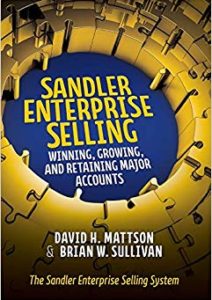Team selling. We know how critical it is in the enterprise selling world. Marshaling your most important organizational assets – your people, to win enterprise deals is a survival skill. The mantra of “Everybody Sells”, when put to work in large pursuits, positions you to face one of enterprise selling’s top challenges – team buying!
While our focus is on the enterprise world, let’s first consider small and medium-sized businesses for some perspective. With SMB’s, you often have the luxury of direct contact with the account’s owner or president. With major accounts, it’s much more complicated. You face buyer networks consisting of individuals from throughout the organization. Purchasing is often prominent as well as legal, accounting and other functions. Which departments are represented is typically determined by the size or type of the purchase and other relevant issues.
How important is understanding the team buying network? Often, it’s the difference between winning or losing. And the selling team has the obligation to know and strategize for the customized buying structure in every pursuit. Researching the hierarchy, where the authority and veto power live and exactly how the decisions will be made are all critical. And the impacts of powerful enterprise influences like ISO 9000, Six Sigma, certifications and quotas can be great. In these areas, what you don’t know can do more than hurt you.
But our keen focus here is on the buyer network itself. For its functional roadmap requires that sales teams be at their best in comprehensively understanding the impactful connections and interrelationships. Do individual departments favor certain products or services or have biases against specific types of solutions? Would accounting, finance or legal, for example, lean towards compliance-oriented solutions while marketing might prefer more flexible options? What about the impact of the interactions among the various departments? Does accounting get along with marketing? What type of working relationship does procurement have with legal? And remember the famous mantra – “People Buy from People”? Functions aside, each individual buying contact is affected by their own personal priorities, pains, and goals that can have a huge impact. At the very least, these dynamics increase complexity. If you dismiss them, you will do so at your own peril. For these variables must be clearly understood and accounted for in both your tactics and strategy. Unfortunately, their importance is often identified in post-mortems as the reasons for losses – the neglected causes of death.
It’s a challenging environment but there’s more. For “People Buy from People” means that individual buyers are, of course, real people. And we know that understanding the behavioral profiles of real people dictates our ability to communicate effectively with them. Programs like DISC enable us to do that well. In SMB’s, the challenge is to understand and adapt to the behavioral profiles of typically one or two key buyers. In enterprise networks, the problem is multiplied. Regarding DISC, is the buying center attorney a “D” – dominant? Is the finance manager a “C” – compliant? What about the marketing manager – an “I” – influencer? The sheer number of buyers alone complicates the analysis but just as with the functions, it’s the interactions among the profiles that are also critical. Effectively identifying and adapting to the complex mix of styles increases communication clarity and helps you build an effective action plan.
With this complex buyer network minefield, how can selling teams prevail? Comprehensive preparation in market, territory and account planning is mandatory. And so is following practical Go/No-Go processes. With these fundamentals in place, though, team selling itself accelerates your chances of success. For when your selling team is truly engaged, you earn the right to put alignment to work because your colleagues bring their own functional perspectives to the pursuit. Perspectives to connect with buying team counterparts. Matching technology with technology, legal with legal and finance with finance makes great sense. The aligned pairs communicate better because they speak the same language – ducks with ducks! And actively engaging your colleagues with prospects in the pursuit is hugely beneficial in another way. For exposing the substance of your organization to the account provides a view into the value you’ll bring after you’ve won the business, which should be a significant competitive advantage. And these connections can be enhanced through behavioral profile matching, increasing the likelihood of alignment through strategized interactions between complementary communication styles. Again, ducks with ducks.
Team buying involves smart business people who come prepared. And while individual buyers have different functional and behavioral frames of reference, they all have one thing in common. They are subject matter experts in the business of the account that you’re working hard to win. Understand that and be strategic in your team selling. Devote the time and effort and you’ll earn the right to make the alignment of team buying with the team selling a winning competitive advantage.












Comments